Blood on the station floor. Mine! Yes, another fall on the escalator as I hurried to catch the high-speed German ICE (Inter City Express) train in Amsterdam’s Centraal Station. Heavy bag deciding to go south, me following. A bang on the head and a cut finger. Police there in an instant, tissues materialised to stem the dripping, wanting me to sit and calm down … and the train to leave in two minutes. And you know how German trains leave as the second hand hits the Twelve. No, not dizzy, shaken but okay .. a sprint “under escort.” Just made it, wife shaking her head. Lifts from now. “But it was the suitcase,” I blurted to no avail, or sympathy, although she did put a bandaid on my “wound.”

The Ice Train at the station in Dusseldorf, Germany A quick "hop out."
We left for Basel, Switzerland in a ghoulish dawn light, with wispish figures on bikes in the streets outside. For all you statisticians, there are in Amsterdam alone (Population 799,000), 880,000 bicycles with 100,000 annually, reported as stolen. About 25,000 are hauled out of the 100 kilometres of canals and waterways (Are the rest just recycled?!) which are spanned by 1,281 bridges in Greater Amsterdam. The Centraal Station, which we just left, is built on top of 11,000 wooden piles. Yes, someone collects all this stuff!
As dawn came slowly upon us, and the train showed us its pedigree. The countryside opened up, like a hand unclenched and lying flat. Everything was flat, not a fence in sight but criss-crossed by canals dotted with “night and day” bovines and shade of grey woolies. No wonder the cattle are called Friesians, for is was below freezing outside, even snow on the ground. As for the sheep, why that is what the fleece is for and why we have Ugg boots! Here and there a church with steeple rising out of the roofs, and rows of spindly birch trees awaiting springs blessing, pointing the way to an invariably large house with an even larger barn.

On the way to Basel; Fraulein and Fido, in the snow!
On board the train, we had simply taken a seat. We had a First Class ticket, and couldn’t see the seat numbering - and retained them all the way to Basel despite the many stops the train made. Conductors merely gave a nod, checking their electronic duvalackey that we were legit. At the “food kiosk” car, we had breakfast, my wife a tiny bottle of Cremant a’Alsace, sparking wine not unlike the Baby Cham of old, served by a German woman who raved about her time spent as a backpacker in Bondi, Sydney! The “border crossing” was seamless and nowhere did any authorities call for passports, Germany or Switzerland, somewhat incongruous in the light of heightened security. After Frankfurt, the snow came down, and kept up its flurry, all the way to Basel.
It was a Sunday afternoon and we took a community bus to the airport, but the ticket machine wouldn’t take Euro (later we found most places took Euro, but not the bloody machine!). Eventually issue resolved; hire car - a brand new Nissan - and we set off following “Aussie Bruce” on cousin’s preprogrammed TomTom. When an hour later - and having passed a sign to Colmar - we appeared headed for Berlin, or Oslo or the North Pole, we said loudly, “Bugger off Bruce, you Bastard,” a vernacular he would have understood, and turned to the vehicle system. After much dabbling with direction, lingo, and the gathered darkness, we soon had our dulcet English lass, Jane, and through a spider web of back roads, eventually found Colmar.

All is still in the early morning light on an early morning walk in Colmar, France

No fish today; boats are iced up!
And what a find is Colmar! If it is not on your bucket list, put it there. We had wonderful accommodation at My Sweet Home, within the Old Town, old facade at the front on the cobbled Rue du Lycée, ultra modern beyond, kitchen cum sitting room, great bedroom and bathroom. Nearby is the School Bartholdi, named after the great ‘sculptor’ of Miss Liberty, at the “entrance of New York,” who was born and lived in Colmar. His house is now a museum, which unfortunately, like much in winter, was closed.

Then the sun and the swan came out; Colmar
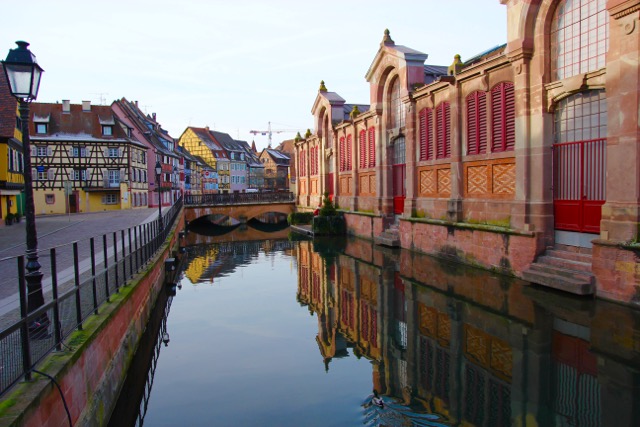
The old covered market on the right
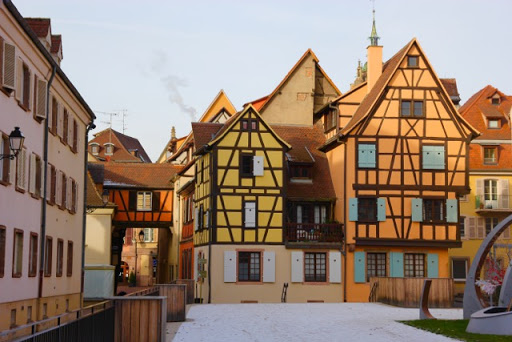
... and the colours continue while people are absent ... but in a few months ...
We went straight to a nearby restaurant, just over the renowned Rue Turenne, chocolate box pretty bridge, the most photographed site in Little Venice. Alas, not open to diners before 7pm, so we found another nearby, where we could have a drink and nibbles, but no food before 7pm. (This was common practice wherever we travelled in Alsace.) No matter, a Dutch couple now living in France, got the table next to us and a US military trauma psychologist on a weekend break from nearby Germany, on the other side. And over the sauerkraut, Frankfurters, slabs of ham and potatoes, good Alsace food, a local beer and wine, we fully enjoyed our evening.

The canal leading to the Fishermen's wharf
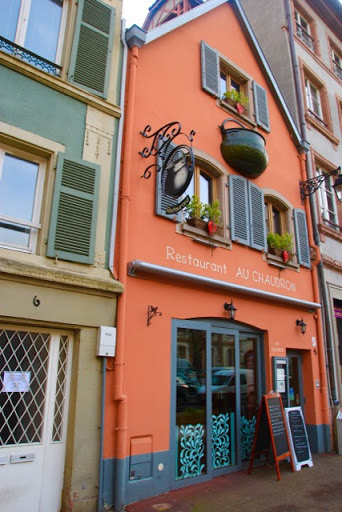
Vibrant coloured Cauldron Restaurant-coffee house
Colmar - you simply run out of superlatives. It is as though it is vacuum-packed in a ziplock bag - albeit that for our visit it had been kept in the fridge - which is forever set in the Fifteenth Century. You’d be a fool not to walk everywhere. There is so much to see and photograph that it leaves you and your camera puffing. I am sure that in the C20, Mr Kodak would have made a fortune in printed photos and would have cursed the arrival of the digital camera. Even if you take a thousand shots there are still more around the next corner, historic and decidedly romantic, especially in the spring and summer when everything is in the reign of the kingdom of the flower, full of waterfall like overflows. Mind you, then it is full of humanity and while most cars would be kept out and the cobbles polished by thousands of soles, it is best seen, in my view, sans-jostling! And the warmth of its colours made even the winter temperature of -2 c, bearable. I will simply let the photos, and our walking, do the talking.

The Cathedral at Colmar

Home of the wealthiest citizen, a merchant, in C15
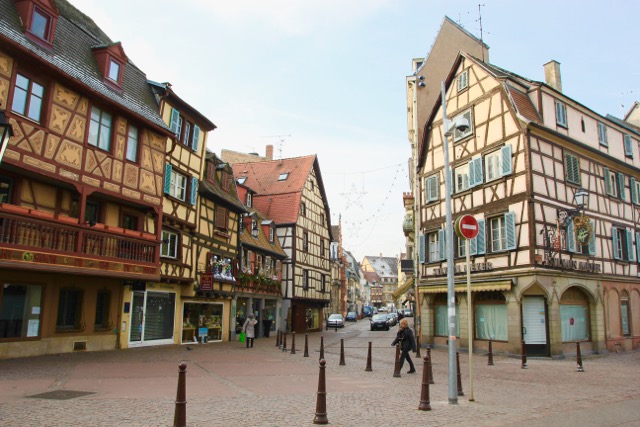
Local window shops while a rugged up local passes

Place to sit and read, if it wasn't -2 degrees!
After a wonderful breakfast at the C16 Hotel Le Marechal, with its window box view of the Rue Turenne bridge and the canal’s gliding swans, we set off to drive to Metz via the Alsace wine route. Lots of Grand Cru (recognised regional quality) sloping vineyards with pruners at work, the ruins of numerous castles and ramparts, and trucks, trucks and more trucks! We passed by numerous attractive villages, each with a church that would pass for a cathedral in Australia, some like Ribeauville, already filled with a tourist bus or five in that way that one gives berth to many. We chose to go to one a few kilometres off the highway, Riquewihr, a still fortified “Medieval and Renaissance city” with 13th, 15th and 17th Century towers (including a Thieves tower (with appropriate torture dungeon! closed during January!). And operating parking meters in a snowy, icy, car park, just outside the walls!

The fortified Gatehouse, the C15 walled "city" of Riquewihr, Alsace Wine Route
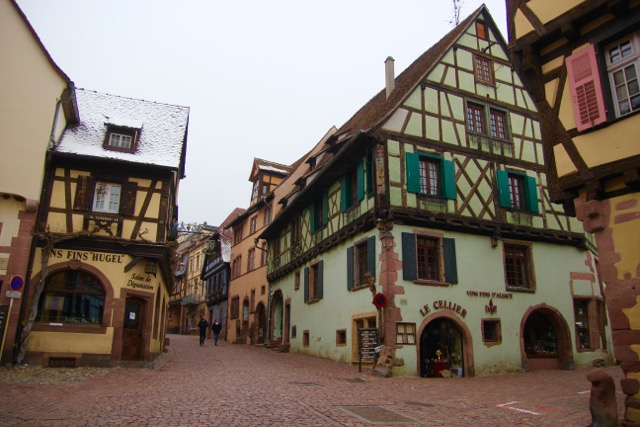
The main street of Riquewihr - bloody pedestrians!
We passed through the ramparts at an outer gate with its portcullis drawn, machicolations from where we could be doused with boiling oil. The cobbled street sloped down to another gate, but half way down we found a coffee shop, and happily went inside for sustenance and a light as a feather eclair. Oh the French do have a way with pastries! And the chance, of course, for a free pee before I was again at the mercy of the “dunny money grabbers.”
After a look-see at the wonderfully preserved houses, and sighting the arrival of a tourist coach, we made our way up a snowy, forested climb in the Voges Mountains, to Chateau du Haut-Koeningsbourg, the plain below bedecked in fog. The castle site on a rocky outcrop 800 metres above the Rhine plain, was fought over and besieged by many, the French, Swabians, and burned down by the Swedes after the Thirty Years War 1618-1648. Trees grew through ithe ruins and it was abandoned. Then came Kaiser Wilhelm II, after the Germans had taken Alsace in the Franco-Prussian War (1870-71). He looked upon the site as a place to build another Neuschwanstein, not in a Romanesque (Disneyland!) style, but as a “real German castle,” and from 1900 to 1908, he personally visited, many times, to oversight reconstruction work. (He even had his own railway station in the village of Saint Hippolyte, below.) In 1937, the masterpiece French film, The Grand Illusion, the forerunner to “the WWII Great Escape,” had its “escape proof castle” scenes shot there. The snow was deep, the road icy and a sign at the castle said it had a “donjon et canons repellant aussi.” Here was an Aussie who took the hint, so a quick look, and we slowly made our way down the switchback road. Soon we were in a six kilometres long tunnel, and on the freeway to Metz.

The Castle Haut Koeningsbourg, Alsace; rebuilt for Kaiser Wilhelm II
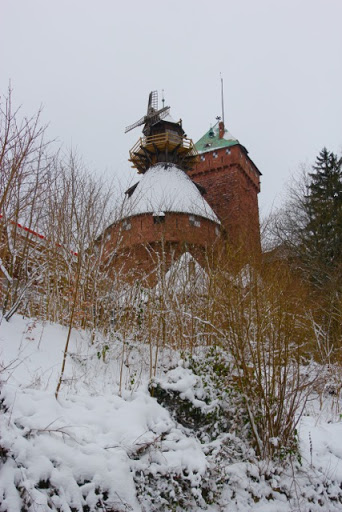
Windmill aboard, for Castle needs!
The high speed freeway to Metz is a beauty and while the speed is an advisory 120kph, there are few abiders. More likely the “abide with me” crowd as they zoom past. And I thought too, of my favourite poet, Ogden Nash (with apologies to his Song of the Open Road):
I think that I will never see
A truck as lovely as a car
Indeed unless the trucks do stall
I’ll never see a car at all.
My wife thought to take a nap. “Fine” I said, "I’ll wake you when we getz to Metz.” The hour and a bit passed peacefully, even when I skirted Nancy.
Metz, too, is a toddling town and certainly not a Mess, which is the way that it is pronounced. Quite the opposite, both regal, graceful and in many parts, the Imperial capital it once was. But walk it you must. Even if like us, you need to park your car in a far away car park. Our hotel, Le Mondon, was not hard to find and if you mounted the footpath you could unload and take the tiny time to make-a-cuppa-tea lift, oh so slow, to the first floor reception. Small room but right on the roundabout Place Mondon, with its wagon wheel of stately buildings, especially along Avenue Foch. It is a 10 minute walk to the Place de la Republique, Galleries Lafayette, and the pedestrian Rue des Clercs, to Metz’s simply stunning Cathedrale St Etienne, and other sites. That was in the snow; double it if heeding the big Verglas warning signs.
The Gothic Cathedral, on Place d’Armes is every way as intimidating and impressive as any cathedral I have seen, even the more famous one at Rouen. It was conveniently started for statistical Neanderthals like me, in 1234, and has an enormous amount of stained glass windows, which give it a lightness not seen in many cathedrals. It dominates the skyline, and its entrance is adorned with beautiful carvings, as well as a bevy of beggars as it probably has been through the ages.

Metz Cathedral - conveniently placed "pissoir," French street toilet, at backside!
I had intended to spend a day in Verdun, but the roads were icy and the places I wanted to see there, were closed. It gave us an extra day in Metz, for which I was grateful. It has always been a sought after strategic place at the confluence of the Moselle and Seille rivers, sacked by Attila the Hun, fought over by kings and tyrants, fortified by many, French ruled then German, then French again then German and now French again. The forts held up for months, the galloping Patton’s bid to enter Germany, much to his anger before accepting the folly and significant loss of life, in frontal attacks.

Metz housing along the River Seille

Place Mondon, grand street in the Imperial Quarter
I started my meandering at the Republique, a large square, surrounded by golden coloured, Jeumont-stone buildings. One side harboured the well guarded Marshal Ney Military Headquarters, and the Arsenal, now a concert hall. Large granite bank buildings stood at one end. At the other end is the statue of Marshal Ney (Napoleon called him “my bravest General”), then wonderful formal gardens leading down to the Esplanade along the Moselle, the area turned into a summer plage (beach). In between, there are cafe-society bistros (with blanketed patrons under gas heaters).

The part frozen River Moselle where in summer it transforms into a "beach"

Looking back down the part frozen Moselle

The walk along the Moselle, city ramparts and the Protestant church
I followed the along the swan be-festooned Moselle, past the 1898 Kaiser Wilhelm inspired, Protestant New Temple on its own island, then along the ramparts to the confluence with the Seille. Gardens and park lands everywhere, testament to Metz’ “green status.” I followed the old walls to the Porte des Allemands, a strategic choke point on the Seille as Metz was at the cross-roads of European trade for centuries. The castle was invariably sacked at a siege in the C13, but in the C17 the great castle builder of France, Vauban, strengthened the fortifications. It has a certain picture book look.
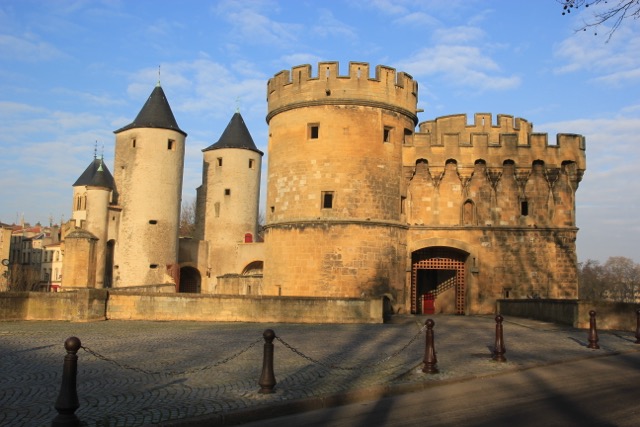
Castle on the Seille river, strengthened by C17th master castle builder Vauban
On to the very Germanic Imperial Quarter, with its built to last, grey stone and granite Romanesque Railway Station (1908) and Post Office (1911), and home through various triumphant colonnades. After a quick detour through the station to see the “Chinese hat,” Pompidou cultural centre. Quaint architecture, very different from the “pipes on the outside” Pompidou Centre in Paris. I wandered back to the hotel along the more lightly fashioned residences bordering the salubrious Avenue Foch. Later we returned to gourmet lunch at a Caves de Vins, (wine cellar), innovative dishes with foie gras as I had not seen it used before. When my wife wanted pepper with her delicious tagliatelle, he simply said “Alor’s, it will zpoil ze deesh" and refused! The goats cheese on fig bread with a glass of Sauterne was a knock out. Everywhere our strangled attempts at schoolboy French was met with, “English?” and a “knowing look.” It changed immediately I replied, “Non, l’Australien, non Rosbifs.” Service immediately improved, explanations and all. With numerous young, staff many had spent enjoyable time in Australia. Sometimes your country serves you well.

Along Avenue Foch, in the Imperial Quarter

Solid German architecture, when they had it "on loan!"
We drove the next day to Thann on a switchback road through the beautifully be-snowed Voges Mountains. Again the scourge of trucks as this bitumen tiddler forms a major connection between Germany and parts of France. By pot luck and a quick study of TripAdvisor, we found the Hotel du Parc, the stately C19 manor house of a former Resistance fighter who had died at the hands of the Gestapo. As a hotel, it was beautifully furnished with antiques, period furniture … and there was a staircase … Like Atlas, I had to lift the suitcases, and then bring them down in the morning - and with my form! It was the off season (there were no other “guests”) but the owner drove a Maserati, indicating the pickings were good “in season.” We had lunch in Thann, a nice little town, but after Colmar and Metz … For dinner, a little 2star hotel with restaurant, and had our last Alsace heavy cuisine, tasty of course.

The Hotel du Parc, Thann
Next morning it was on to Switzerland, skirting around the small road we had initially wanted, but too many roads were closed by snow, so we stuck to the main roads, and were soon in Lenzburg. No border check that we saw, no security. Lots of roadworks, a castle at Aargau on the Aare river, and in no time we were in Lenzburg at the very pleasant Hotel Krone. A lovely little town to explore. Merci became danke schoen and I decided to take the icy steps (I stopped counting at 400) up and thought, fine, but how the hell do I get down! The sun shone, but the ice would not melt for days. Castles must have an escape route, and it did indeed, so after a quick squizz, I took my feet, to the sunny side of the castle, as did a few other visitors, and the way down was like a sunbeam. Time for a walk around the attractive little town, but after Colmar and Metz … The room was excellent, dinner in a cosy little Swiss restaurant in the old town, and an excellent Swiss rosti to yodel about.

The Castle at Lenzburg, Switzerland, one of Switzerland's oldest
Next morning we set out for Zurich airport, but got into the vicinity so quickly that we decided to go on briefly to Lucerne. It has such a beautiful waterside setting and we had both been there before, but after an hour we headed back. We had bypassed the turn to Zug, a spot which perhaps we should have visited, but time intervened. Car to return, petrol tank to fill, and a few hours at Zurich’s wonderful airport before the 6 hours to Dubai and to “explain” where we had entered the country. Well, obviously, where the officials were not. He looked as dark as chocolate … but stamped our passports anyway. So much for Europe’s “poor-us borders!”

Cruising on Lake Lucerne, Switzerland on a misty morning
There is much beauty in the parts of Europe we saw, in any weather. Summer is stunning if the weather is good, but it comes with crowds, tour buses, accommodation filled, roads clogged and queues at attractions. Winter comes with scarves and coats, atmospheric cosy restaurants, good food and no rushing you out the door, fewer crowds, often the run of the village, albeit many attractions are closed. Still the same toilet fees (desperation in Lucerne and no Swiss coins, a feigning attendant, so a two Euro pee - the only coin I had!) parking and toll costs, same places like the Post Office and many shops, closed down for a lunch, same wonderful scenery although forget getting up early as it stays dark till 8.00am and starts to get dark about 4.00pm. While spring, summer and autumn is preferred, don’t be deterred by winter. And no queue at the loo can be a God send!
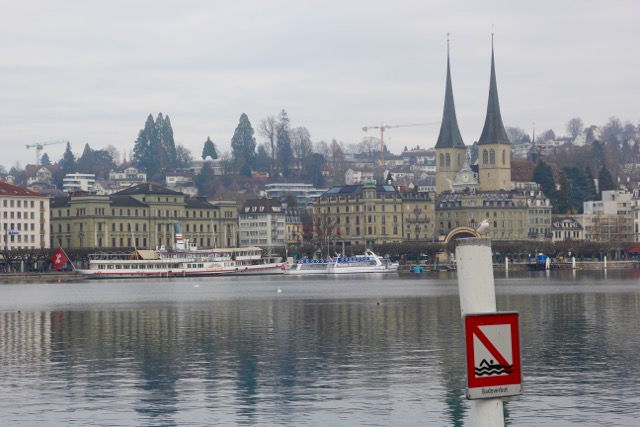
Lake Lucerne: not even Iron men and women would be tempted - VERBOTEN!
Winfred Peppinck is the Tales of the Traveling Editor for Wandering Educators
All photos courtesy and copyright Winfred Peppinck
